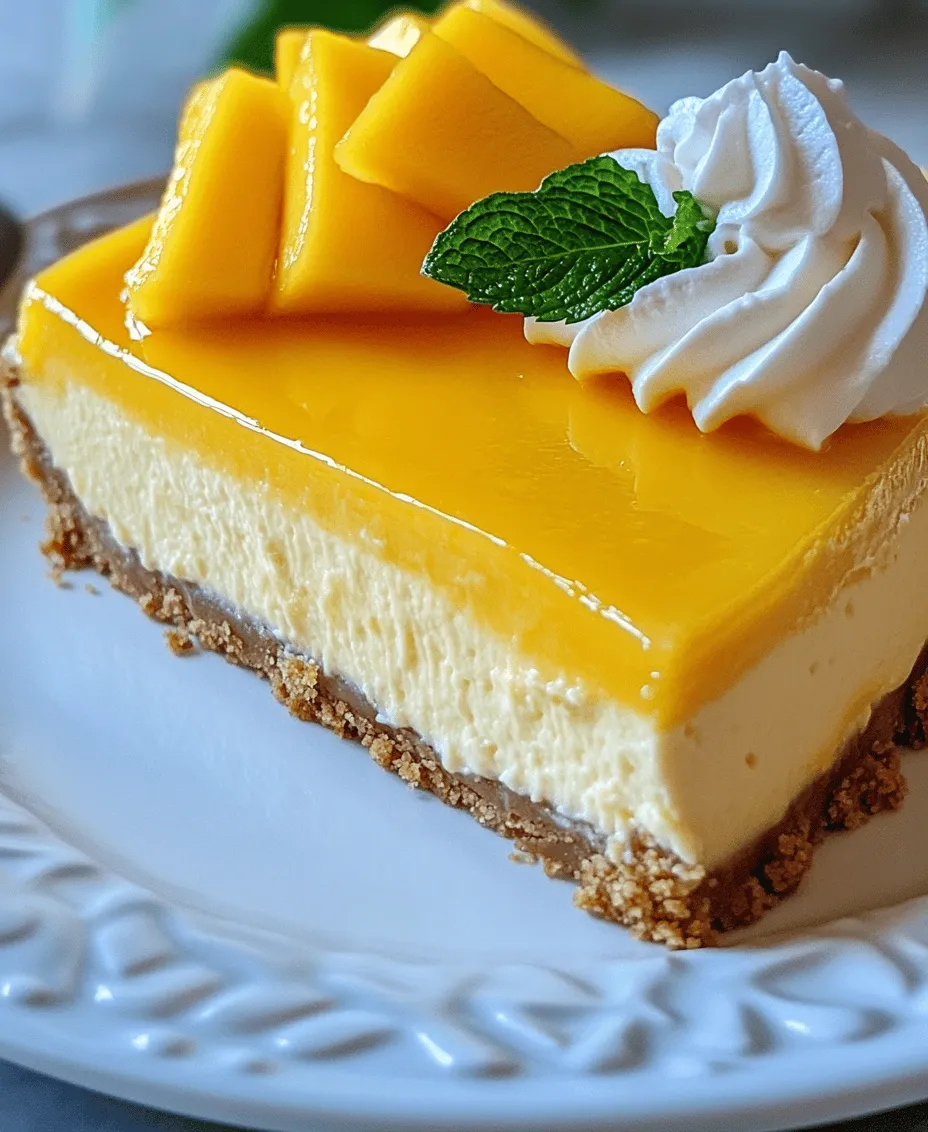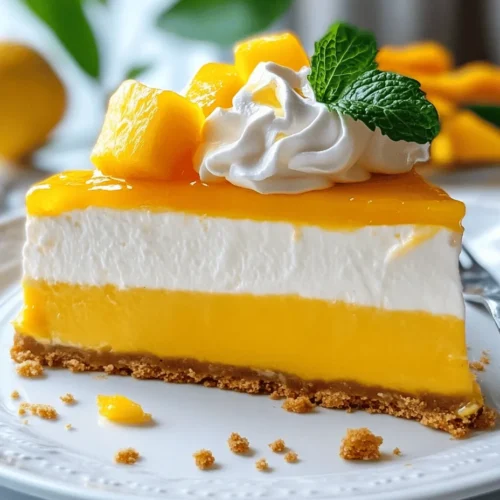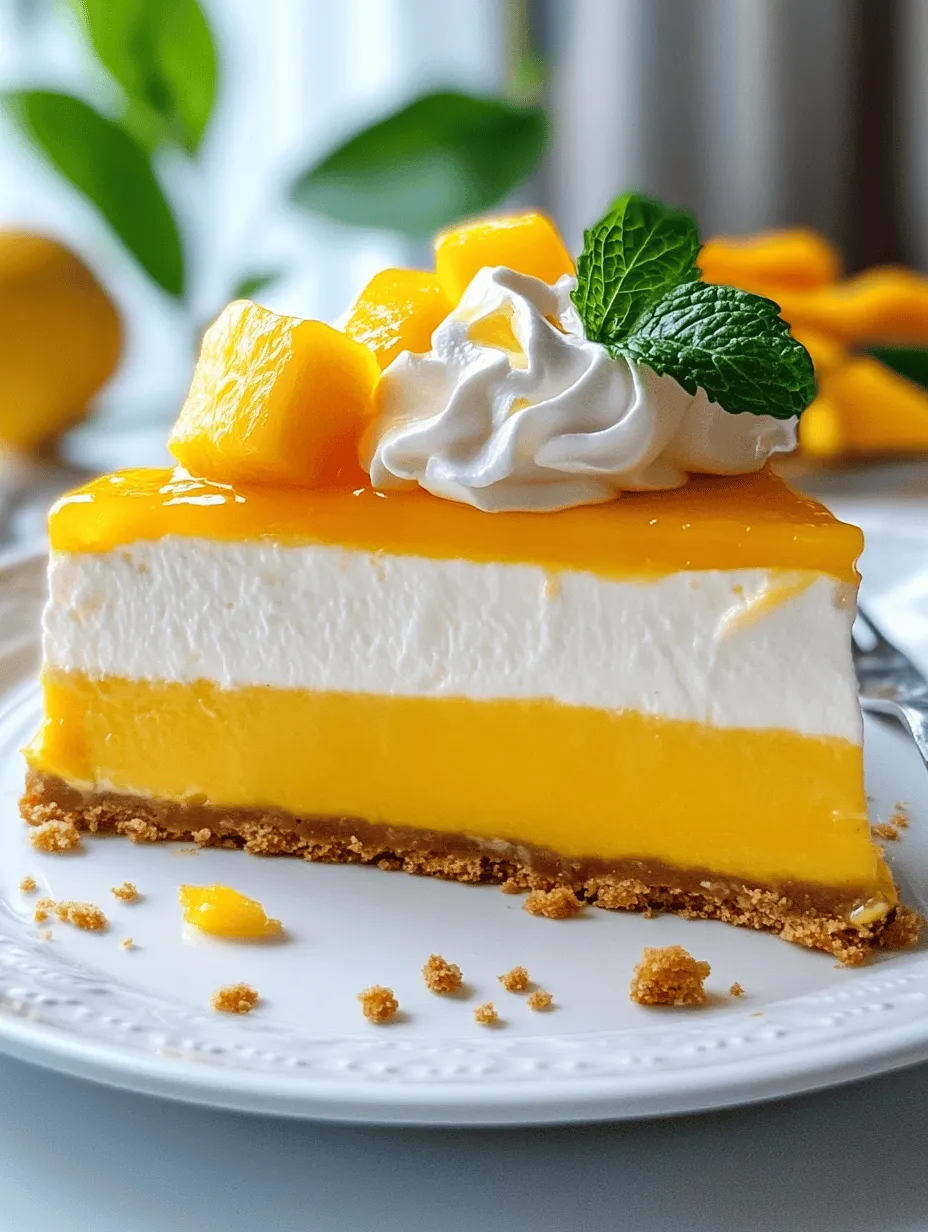Introduction
Cheesecake is a dessert that has captured the hearts and palates of many around the world. Its rich, creamy texture and decadent flavor make it a favorite choice for special occasions and casual gatherings alike. From classic New York-style to indulgent chocolate versions, the versatility of cheesecake allows it to be adapted in countless ways, appealing to a wide range of tastes. Among these delightful variations, the mango cheesecake stands out as a refreshing and tropical twist that transports dessert lovers straight to a sun-soaked paradise.
This mango cheesecake recipe offers a unique blend of creamy goodness and vibrant fruitiness, making it an extraordinary treat for any occasion. The combination of smooth cream cheese and luscious mango puree creates a dessert that is not only visually stunning but also a feast for the taste buds. The natural sweetness and tropical flair of mango elevate the cheesecake experience, ensuring that each slice is a moment of bliss. Whether you’re a fan of traditional desserts or adventurous enough to try something new, this mango cheesecake is a must-try.
The Allure of Mango Cheesecake
The history of cheesecake dates back thousands of years, with roots traced to ancient Greece, where it was considered a source of energy for athletes during the Olympic Games. Over time, cheesecake has evolved, with various cultures putting their unique spin on this classic dish. The introduction of cream cheese in the United States during the 19th century revolutionized cheesecake, leading to the creation of the smooth, creamy texture we know and love today.
In contrast, mangoes have a rich cultural significance in many tropical cuisines. Known as the “king of fruits,” mangoes are celebrated not only for their delicious flavor but also for their nutritional benefits. High in vitamins A and C, as well as fiber, mangoes serve as a healthy addition to desserts, enhancing both taste and texture. The sweet, juicy flesh of the mango pairs seamlessly with the creamy components of cheesecake, creating a delightful balance that is hard to resist.
This mango cheesecake recipe artfully combines traditional elements of cheesecake with the refreshing flavor of mango. The creamy base is complemented by a crunchy graham cracker crust, while the vibrant mango puree adds a burst of color and sweetness. This dessert is perfect for summer gatherings, birthday celebrations, or simply as a treat to enjoy at home. With its stunning presentation and rich flavors, mango cheesecake is not just a dessert; it’s an experience that delights the senses.
Ingredients Breakdown
Before diving into the preparation of this delicious mango cheesecake, let’s take a closer look at the key ingredients that contribute to its delightful flavor and texture.
Graham Cracker Crumbs
Graham cracker crumbs form the foundation of the cheesecake, providing a crunchy base that contrasts beautifully with the creamy filling. The sweet, slightly nutty flavor of the graham crackers enhances the overall taste of the dessert, while their crumbly texture adds an enjoyable bite. To achieve the perfect crust, you can either purchase pre-made graham cracker crumbs or crush whole graham crackers in a food processor.
Sugar
Sugar is an essential component in any cheesecake recipe, as it balances the flavors and contributes to the overall sweetness of the dish. In this mango cheesecake, sugar not only sweetens the filling but also helps to create a smooth texture. It is important to use granulated sugar for the crust and filling, ensuring that it dissolves completely during the mixing process.
Unsalted Butter
Unsalted butter plays a crucial role in enhancing the richness of the graham cracker crust. It binds the crumbs together, creating a cohesive base that holds the cheesecake filling securely. Additionally, the buttery flavor complements the sweetness of the sugar and the creaminess of the cheese, resulting in a well-rounded dessert. Be sure to melt the butter before mixing it with the graham cracker crumbs for a uniform consistency.
Cream Cheese
The star of any cheesecake, cream cheese is responsible for the rich, creamy texture that defines this dessert. When blended, cream cheese becomes smooth and velvety, creating a delightful mouthfeel. It is essential to use full-fat cream cheese for the best results, as low-fat alternatives may not yield the same luxurious texture. Allow the cream cheese to come to room temperature before mixing to ensure a lump-free filling.
Vanilla Extract
Vanilla extract is a simple yet powerful ingredient that adds depth and complexity to the flavor of the cheesecake. Its warm, sweet notes complement the cream cheese and mango, enhancing the overall taste of the dessert. Use pure vanilla extract for the best quality and flavor, as imitation vanilla may not provide the same richness.
Eggs
Eggs serve a vital function in this mango cheesecake, acting as a binding agent that helps to hold the ingredients together. They contribute to the structure of the cheesecake and provide a slightly firm yet creamy texture. For the best results, use large eggs, and ensure that they are at room temperature before mixing them into the filling.
Mango Puree
Mango puree is the star ingredient that takes this cheesecake to new heights. It adds a vibrant orange hue and a refreshing tropical flavor that balances perfectly with the creamy filling. To prepare the puree, you can either use fresh, ripe mangoes or canned mango puree. If using fresh mangoes, simply peel, pit, and blend the fruit until smooth. The natural sweetness and richness of mangoes not only enhance the taste but also add nutritional benefits, making this dessert a guilt-free indulgence.
Whipped Cream and Fresh Mango Slices
For a stunning presentation and added flavor, whipped cream and fresh mango slices are used as decorative toppings. The whipped cream adds a light, airy texture that contrasts with the dense cheesecake, while the fresh mango slices provide a pop of color and freshness. Together, these garnishes elevate the dessert, making it visually appealing and even more delicious.
Step-by-Step Instructions
Now that we have covered the ingredients, let’s dive into the step-by-step instructions for preparing this delectable mango cheesecake. The process is straightforward and can be broken down into a few key sections: preparing the crust, making the filling, and assembling the cheesecake.
Preparing the Crust
1. Preheat the Oven: Begin by preheating your oven to 325°F (160°C). This ensures that the cheesecake bakes evenly and achieves the perfect texture.
2. Combine Graham Cracker Crumbs and Butter: In a mixing bowl, combine the graham cracker crumbs and melted unsalted butter. Mix until the crumbs are fully coated and resemble wet sand.
3. Press the Mixture into a Springform Pan: Lightly grease a 9-inch springform pan with cooking spray or butter. Pour the graham cracker mixture into the pan and press it down firmly using the back of a measuring cup or your fingers. Ensure that the crust is evenly distributed across the bottom and slightly up the sides of the pan for added stability.
4. Bake the Crust: Place the crust in the preheated oven and bake for about 10 minutes, or until it is lightly golden and fragrant. This step helps to set the crust and enhances its flavor. Once baked, remove the crust from the oven and let it cool while you prepare the filling.
Making the Filling
1. Beat the Cream Cheese: In a large mixing bowl, use an electric mixer to beat the cream cheese until it is smooth and creamy. This step is crucial for achieving a lump-free filling, so take your time and scrape down the sides of the bowl as needed.
2. Add Sugar and Vanilla: Gradually add granulated sugar and vanilla extract to the cream cheese. Continue to mix until the mixture is well combined and creamy.
3. Incorporate the Eggs: Add the eggs one at a time, mixing well after each addition. Be careful not to overmix, as this can lead to a dense texture. Just mix until the eggs are fully incorporated.
4. Add Mango Puree: Gently fold in the mango puree, mixing until the filling is smooth and well blended. The vibrant color and flavor of the mango will transform the cheesecake filling into a tropical delight.
5. Pour the Filling into the Crust: Carefully pour the mango cheesecake filling over the cooled graham cracker crust, spreading it evenly with a spatula.
Baking the Cheesecake
1. Prepare a Water Bath: To prevent cracks in the cheesecake, it’s best to bake it in a water bath. Wrap the bottom of the springform pan with aluminum foil to prevent water from seeping in. Place the wrapped pan inside a larger baking dish and fill the outer dish with hot water until it reaches about halfway up the sides of the springform pan.
2. Bake the Cheesecake: Place the water bath in the oven and bake the cheesecake for approximately 50-60 minutes, or until the edges are set but the center is still slightly jiggly. The cheesecake will continue to firm up as it cools.
3. Cool and Chill: Once baked, turn off the oven and leave the cheesecake inside with the door slightly ajar for about an hour. This gradual cooling helps prevent cracks. Afterward, remove the cheesecake from the oven and water bath, and let it cool to room temperature. Once cooled, cover it with plastic wrap and refrigerate for at least 4 hours, or overnight for the best flavor and texture.
As you can see, making mango cheesecake is a delightful process that yields an impressive dessert. The combination of creamy cheese and tropical mango creates a perfect balance that will leave your guests craving more. Stay tuned for the next part of this article, where we will cover the finishing touches, serving suggestions, and answer some common questions about this tropical delight.

Preparing the Crust
The foundation of your mango cheesecake is its crust, which adds a delightful crunch and balances the creamy filling. To prepare the crust, start by gathering the following ingredients:
– 1 ½ cups of graham cracker crumbs
– ½ cup of unsalted butter, melted
– ¼ cup of granulated sugar
– A pinch of salt
Instructions:
1. Mix the Ingredients: In a large mixing bowl, combine the graham cracker crumbs, melted butter, granulated sugar, and salt. Stir until the mixture resembles wet sand, ensuring that the crumbs are evenly coated with butter.
2. Press into the Pan: Choose a 9-inch springform pan for easy removal later. Pour the crumb mixture into the bottom of the pan. Using the back of a measuring cup or your fingers, press the mixture down firmly and evenly across the bottom. Make sure to compact it well to create a sturdy base for your cheesecake.
3. Pre-Bake the Crust: Preheat your oven to 350°F (175°C). Place the springform pan with the crust in the oven and bake for about 8-10 minutes, or until it is lightly golden. This step helps set the crust and prevent it from becoming soggy once the filling is added. After baking, remove the crust from the oven and let it cool while you prepare the filling.
Making the Cheesecake Filling
The key to a smooth and creamy cheesecake filling lies in the way you beat your ingredients. For this mango cheesecake, you will need:
– 16 ounces (2 packages) of cream cheese, softened
– 1 cup of granulated sugar
– 1 teaspoon of vanilla extract
– 1 cup of ripe mango puree (fresh or canned)
– 3 large eggs
– 1 tablespoon of all-purpose flour (optional, for added stability)
Instructions:
1. Beat the Cream Cheese: In a large mixing bowl, beat the softened cream cheese with an electric mixer on medium speed until it is creamy and smooth, about 2-3 minutes. Make sure there are no lumps, as this will affect the texture of your cheesecake.
2. Add Sugar and Vanilla: Gradually add the granulated sugar and vanilla extract to the cream cheese. Continue to mix until fully incorporated and smooth.
3. Incorporate Mango Puree: Gently fold in the mango puree until it is well-blended with the cream cheese mixture. This will infuse the cheesecake with the tropical flavor of mango.
4. Add Eggs: Add the eggs, one at a time, mixing on low speed after each addition until just blended. Avoid overmixing, as this can introduce air into the batter and lead to cracks during baking.
5. Optional Flour Addition: If you choose to use flour for added stability, sprinkle it over the batter and mix just until incorporated.
Baking the Cheesecake
The baking process is critical for achieving the perfect texture in your mango cheesecake.
1. Prepare for Baking: Preheat your oven to 325°F (160°C). This lower temperature will help prevent the cheesecake from cracking and ensure it cooks evenly.
2. Bake the Cheesecake: Pour the cheesecake filling over the cooled crust in the springform pan. Smooth the top with a spatula. Place the pan on a baking sheet to catch any potential drips, and bake in the preheated oven for about 50-60 minutes. The edges should be set, while the center remains slightly jiggly—this is normal and will firm up during cooling.
3. Check for Doneness: To test if the cheesecake is done, gently jiggle the pan. If the center wobbles slightly but is not liquid, it’s ready. Avoid overbaking, as this can lead to a dry cheesecake.
Cooling and Chilling
Once baked, the cooling process is crucial for preventing cracks and achieving a smooth texture.
1. Cool in the Oven: After removing the cheesecake from the oven, turn off the heat and crack the oven door open. Allow the cheesecake to cool in the oven for about an hour. This gentle cooling helps prevent sudden temperature changes that can cause the surface to crack.
2. Refrigerate: After the cheesecake has cooled to room temperature, cover it with plastic wrap or aluminum foil and refrigerate for at least 4 hours, preferably overnight. Chilling allows the flavors to develop and the cheesecake to set perfectly.
Serving Suggestions
When it comes to presenting your mango cheesecake, the visual appeal is as important as the flavor. Here are some enticing serving suggestions:
1. Garnish: Before serving, consider topping your cheesecake with a dollop of whipped cream, fresh mango slices, and a sprig of mint. This not only enhances the presentation but also adds layers of flavor.
2. Plating Ideas: Serve slices on individual plates with a drizzle of mango sauce or a sprinkle of toasted coconut for added texture and taste. Creating a colorful plate can elevate the dining experience.
3. Beverage Pairing: To complement the tropical flavors of the cheesecake, serve it with a refreshing beverage. Consider pairing it with iced tea, coconut water, or a tropical fruit punch for a delightful treat.
Nutritional Information
Understanding the nutritional benefits of your ingredients can help you enjoy this dessert responsibly:
– Mango: Rich in vitamins A and C, mangoes are known for their antioxidant properties. They also provide dietary fiber, which can aid digestion.
– Cream Cheese: While cream cheese is often seen as a decadent ingredient, it also provides calcium, which is essential for bone health. Using reduced-fat cream cheese can help lower calorie content without sacrificing too much flavor.
– Portion Sizes: A typical serving of mango cheesecake is about 1 slice, which can fit into a balanced diet. Moderation is key, and enjoying this treat as part of a varied diet can be perfectly acceptable.
Common Mistakes to Avoid
Making cheesecake can be tricky, but being aware of common pitfalls can help you achieve the best results:
1. Overmixing the Batter: Overmixing can introduce excess air, leading to cracks during baking. Mix just until combined, especially after adding eggs.
2. Skipping the Cooling Step: Rapid temperature changes can cause cracks. Always allow the cheesecake to cool gradually in the oven before refrigerating.
3. Not Using a Water Bath: For an extra step of insurance against cracks, consider using a water bath during baking. Wrap the bottom of the springform pan with aluminum foil and place it in a larger pan filled with hot water. This creates a moist baking environment that helps prevent cracks.
Storage and Shelf Life
Proper storage is essential to maintain the freshness of your mango cheesecake:
1. Refrigeration: Store leftover cheesecake in the refrigerator, covered tightly with plastic wrap or in an airtight container. It will remain fresh for about 3-5 days.
2. Freezing: If you want to store the cheesecake for a longer period, you can freeze it. Wrap individual slices in plastic wrap and then place them in a freezer-safe bag. It can last up to 2 months in the freezer. When ready to enjoy, thaw in the refrigerator overnight before serving.
Conclusion
Making mango cheesecake is not just about creating a dessert; it’s about crafting a delightful experience that transports you to a tropical paradise with each bite. The creamy texture combined with the sweet and tangy flavor of mango creates a treat that is truly satisfying. Whether for a special occasion or simply to indulge, this mango cheesecake is sure to impress.
Encourage yourself to try this recipe at home and savor the joy of creating something beautiful and delicious. The satisfaction that comes from making a homemade dessert is unmatched, and your friends and family will appreciate the time and care you’ve put into this tropical delight. Enjoy every slice of your mango cheesecake and share the flavors of the tropics with those you love.


